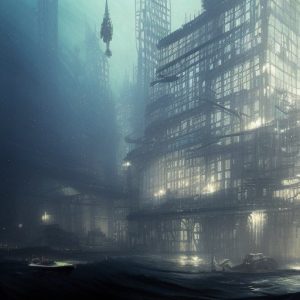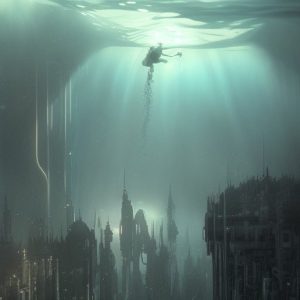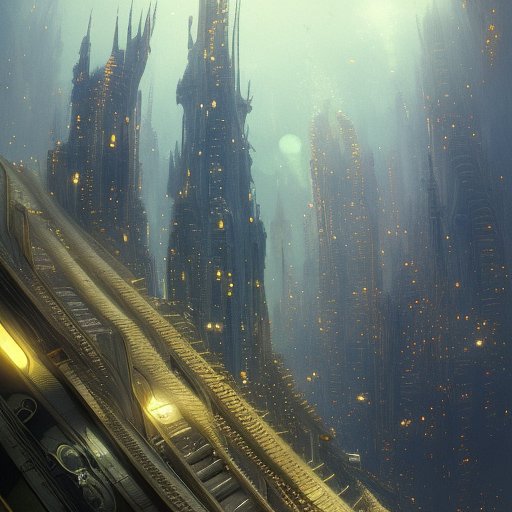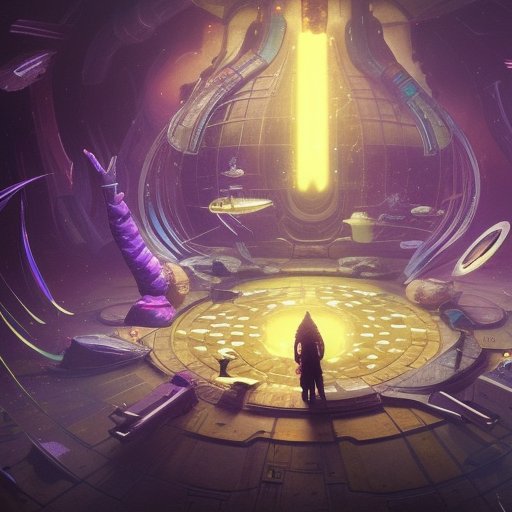
In an age of technological advancement and space exploration, we turn our attention to the depths of our oceans. Welcome to the underwater skyline, a world of limitless potential and uncharted territory. From towering skyscrapers to sprawling infrastructure, the underwater landscape offers a new frontier for human expansion. But with every opportunity comes unforeseen consequences. We’ll look at the technological and societal advancements that make life beneath the waves possible, examine how we can live sustainably in harmony with the ocean, and explore the unknown depths that call to us. Join us on a journey to the underwater skyline, where anything is possible.
I. Introduction
Get ready to take a deep breath and dive into the world of the underwater skyline. In a time filled with technological advancements, it’s no surprise that we’ve expanded our reach from the stars to the depths below. The undersea metropolis is the newest frontier for human survival and evolution, where the sky is not the limit, but merely a suggestion. The underwater skyline is a place where anything is possible, from towering skyscrapers to sprawling infrastructure. It’s a world where humans and creatures of the deep live side by side, where natural wonders exist alongside sprawling cities.

At the heart of the underwater skyline is technology, engineering, and sustainability. To survive and thrive underwater, we must build infrastructure that can withstand the crushing depths and powerful currents. We must also learn to live in harmony with the ocean, using its power to sustain our needs without harming its delicate ecosystem. Humans have adapted to life underwater in ways that would make even the most advanced astronaut envious, using biometrics and exoskeletons to live and work in extreme conditions.
But the underwater skyline is not without its risks and dangers. The deep sea is filled with predators and unpredictable natural phenomena that can threaten life and infrastructure. Yet pioneers are willing to take these risks to explore the depths and discover new wonders, pushing the boundaries of science and discovery.
In this article, we’ll take a closer look at the technology, sustainability, culture, and challenges of the underwater skyline. We’ll explore the unknown depths of the ocean, examine the consequences of our actions, and predict the future of the underwater world. So, buckle up and put on your diving gear because we’re about to embark on the adventure of a lifetime.
II. Technology and Infrastructure
Building the underwater skyline requires technology and infrastructure unlike anything on Earth’s surface. From the moment we breach the surface and set foot in the depths below, we must use our technological prowess to build the cities and infrastructure that will sustain us. This is not an easy feat, given the harsh conditions of the deep sea. The high pressure, lack of light, and powerful currents pose significant challenges that must be overcome. But, as always, human ingenuity has found a way.

To construct the underwater skyline, we’ve developed a plethora of technologies and engineering feats. The buildings and structures are made of advanced metals and alloys that can withstand the extreme pressure of the deep sea. We use cutting-edge construction methods to erect towering skyscrapers and sprawling infrastructure, embedding them firmly in the seafloor.
One significant challenge of building underwater is the need to maintain the infrastructure continually. Repairs must be made quickly and efficiently, often in extreme conditions. To address this challenge, we’ve developed underwater robots and drones that can detect and fix issues before they become catastrophic.
Living and working underwater requires specialized equipment as well. We must use biometric and exoskeleton suits to perform tasks that require strength and dexterity. Even essential functions such as breathing require specialized equipment like rebreathers, which recycle exhaled air to provide a continuous supply of oxygen.
The underwater skyline is a marvel of human technology and engineering, a testament to our relentless curiosity and desire to push the limits of possibility. It’s a place where towering structures and innovative infrastructure harmoniously coexist with the natural wonders of the deep sea. But, as we’ll explore in the coming sections, all of this comes at a cost. The technology and infrastructure that have given us so much also pose significant risks to the ocean’s delicate ecosystem, and finding balance between progress and conservation remains a critical challenge.
III. Sustainable Living
Living in the underwater skyline isn’t just about surviving, it’s about thriving in harmony with the ocean. To achieve this, we must harness the power of the ocean and use its resources sustainably. The underwater world is a treasure trove of natural energy, and we must learn to harness it without destroying the ocean’s delicate ecosystem.

One way to do this is through the use of underwater turbines, which can harness the power of ocean currents to generate electricity. This renewable energy source would allow us to power entire underwater cities without harming the environment.
Another sustainable living solution is seaweed farming. Not only does seaweed absorb carbon dioxide, helping to combat climate change, but it also provides a valuable food source for underwater inhabitants. Seaweed can also be used to create biofuels, further reducing reliance on nonrenewable resources.
In addition to renewable energy and sustainable food sources, waste management is a significant challenge in the underwater skyline. Our waste can’t simply be dumped into the ocean, as it could harm the delicate ecosystem. Instead, new technologies have been developed to convert waste into energy or biodegradable materials that can be safely returned to the ocean.
Sustainability isn’t just about our impact on the environment, but also on our social and economic systems. The underwater skyline has the potential to be a model of a sustainable, equitable society where everyone has equal access to resources and opportunities.
However, we must be mindful of our actions and the impact they have on the ocean. The consequences of unchecked pollution or overfishing can reverberate throughout the entire ecosystem, harming both humans and creatures of the deep alike. But by working together and taking responsibility for our actions, we can create a sustainable underwater world that benefits everyone.
In the next section, we’ll take a closer look at the policies and ethical considerations that must be taken into account in the development of the underwater skyline.
IV. Environmental Policy and Ethics
As the underwater skyline continues to expand, so does the need for environmental policy and ethics. Balancing progress with preservation requires a delicate balance, one that considers the needs of both humans and the ocean. At the core of this balance lies the question of sustainability: how can we build and operate underwater cities that benefit humanity without harming the environment?

One solution is the use of renewable energy and sustainable technologies. Harnessing the power of the ocean through wave and tidal energy, as well as wind and solar power, can provide clean and endless energy for underwater inhabitants. Additionally, biodegradable materials and recycling systems can reduce waste and limit pollution.
But policy and regulation are also needed to ensure that underwater expansion is done responsibly. Strict environmental laws should be put in place to protect the delicate ecosystems of the ocean, such as marine protected areas and restrictions on fishing and mining. Additionally, ethical considerations must be made, such as the treatment of underwater creatures and the impact on indigenous communities.
Ultimately, the decision to expand and sustainably operate the underwater skyline rests on the shoulders of humanity. Are we willing to prioritize the preservation of the ocean and its creatures, or will we choose progress at any cost? In the words of one great science fiction writer, “With great power comes great responsibility.” As we explore the depths of our oceans, we must keep this in mind and make responsible decisions that benefit both humanity and the environment.
The underwater skyline is a new frontier for human expansion, but with that comes unforeseen consequences. As pioneers in a new world, it is our responsibility to balance progress with preservation, ensuring that the underwater world remains a wonder of nature for generations to come.
V. Culture and Society
In the underwater skyline, humans have embraced a new way of life that is both innovative and unique. It’s a world where the ocean provides both sustenance and inspiration for cultural exploration. The underwater ecosystem has given rise to new forms of cuisine, art, and music that are inspired by the creatures and environment of the deep.

The architecture of the underwater skyline is also a sight to behold. The aquatic metropolis is filled with towering skyscrapers, sprawling infrastructure, and AI-powered transportation systems. But it’s not just functional; it’s also visually stunning. The undersea aesthetics feature sleek lines, pastel colors, and bold patterns, creating a futuristic yet organic feel that complements the environment.
Society and culture take on a new dimension in the underwater world as well. With limited space and resources, communities have become tightly knit and self-sufficient. Residents of the underwater skyline have also developed a shared respect and appreciation for the ocean and its inhabitants, recognizing its crucial role in their way of life.
Despite these positive aspects, the underwater skyline also faces its own set of social and political issues. There are debates around equality, access to resources, and the power dynamics between different groups. It’s essential that we address these issues and ensure a fair and just society in the underwater world.
The ocean is also a vast, unexplored frontier, with countless mysteries and hidden wonders waiting to be discovered. Those who choose to live in the underwater skyline are explorers at heart, drawn to the adventure and excitement of exploring the unknown. It’s a society that values curiosity, exploration, and innovation in a way that is uniquely suited to the underwater environment.
VI. Exploration and Adventure
To many, exploring the depths of the ocean is a daunting and terrifying task, with the darkness hiding untold dangers. But to others, it’s an exciting adventure filled with the promise of discovery and exploration. For those who brave the deep, navigating the underwater skyline is a fascinating journey full of majestic and eerie beauty.

As explorers descend into the depths, they’re met with a parade of curious creatures, some familiar, others otherworldly. The bioluminescent jellyfish, schools of glowing fish, and mysterious cephalopods all add to the surreal atmosphere of the underwater skyline. But the sea is not just a wonderland – it can also hide dangerous predators and sudden drops that can trap or crush the unwary.
Yet those who navigate these perils are rewarded by the unique views of underwater cities, with towering skyscrapers and sprawling infrastructure stretching off into the distance. Alongside these modern marvels are ancient wrecks and ruins of ships, submarines, and forgotten structures, a testament to humanity’s impact on the ocean.
There are also other milestones of exploration and adventure to be achieved in the underwater skyline, such as venturing to the deepest trenches or exploring the vast underwater caverns. Beyond that, the unknown depths of the ocean hold limitless possibilities that we’ve yet to discover or even fathom.
The underwater skyline offers a distinct aesthetic and environment, with its own unique challenges and rewards. Navigating these depths offers both danger and opportunity in equal measure, making the underwater skyline a place unlike any other. So if you’re brave enough to explore this fascinating world, grab your gear, and get ready to take the plunge into uncharted territory.
VII. Unforeseen Consequences
As with any grand endeavor, the underwater skyline is not without its risks and unforeseen consequences. While we explore the depths and expand our reach beneath the waves, we must also be mindful of the potential for disaster.

One major risk of undersea expansion is the impact on the ocean’s delicate ecosystem. Construction and development can disrupt natural habitats, and waste disposal can introduce harmful pollutants. We must take great care to minimize our impact and prevent irreparable damage to the ocean’s biodiversity.
Another potential consequence is the risk of disaster in the event of a malfunction or accident. With limited resources and potential difficulty reaching the surface in an emergency, catastrophic events could have severe consequences for the inhabitants of the underwater skyline.
Additionally, the underwater world’s expansion could lead to conflict with indigenous species or even with other human colonies. The race for resources and territory could lead to conflicts that spiral out of control, further endangering both the people and the creatures that call the underwater skyline home.
Finally, we cannot ignore the potential impact of the underwater skyline’s expansion on climate change. The ocean plays a critical role in regulating the Earth’s climate, and our actions could have severe consequences. We must strive to address the issue of climate change on a global scale, taking collective responsibility for our impact on the ecosystem.
As pioneers in this new world, it is our responsibility to be mindful of these risks and consequences. We must take steps to mitigate our impact, develop sustainable practices, and work collaboratively to ensure the safety, harmony, and preservation of the underwater world.
In the next section, we’ll explore the future of the underwater skyline, examining the potential for human expansion and the possibilities that lay ahead.
VIII. The Future of the Underwater Skyline
As we look to the future of the underwater skyline, we see a world of endless possibilities and potential. With each technological advancement and scientific discovery, we move closer to living in complete harmony with the ocean. In the coming decades, we’ll continue to push the boundaries of what’s possible, further expanding our reach into the depths.

One possibility is the construction of entire underwater cities, complete with living quarters, commercial centers, and transportation networks. These underwater metropolises would revolutionize the way we live and work, transforming the ocean into a thriving hub of innovation and advancement. Imagine commuting to work via a high-speed underwater train, while schools, hospitals, and entertainment centers litter the underwater landscape.
Another exciting possibility is the emergence of biotechnology, enabling us to create a new form of underwater life specifically adapted to our needs. These genetically engineered creatures could be designed to assist with underwater construction, transportation, and exploration, taking humanity to new depths never before imagined.
We’ll also see improvements in sustainable living and energy production, harnessing the power of the ocean to sustain our expanding population. We’ll rely on renewable energy sources such as tidal, wave, and geothermal power to power our underwater cities and industries, ensuring a sustainable and green future.
The underwater skyline will not only transform how we live and work but also have far-reaching implications for science and exploration. By discovering and exploring the depths, we’ll uncover vast new ecosystems, biodiversity, and unexplored territory. With each new discovery, we’ll advance our understanding of our planet and further our efforts to explore the mysteries of the universe.
Finally, the underwater skyline could pave the way for a new era of scientific collaboration and global cooperation. As nations work together to explore the depths, we’ll be forced to confront the challenges of our shared planet, promoting a spirit of innovation and progress.






